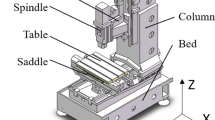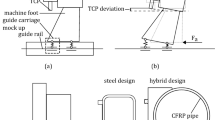Abstract
In this paper, a novel integrated framework for design and optimization of a machine tool structure is presented, which can greatly improve the design quality and efficiency by combining knowledge-based design and multi-stage optimization with the CAD/CAE integration technique. To realize this framework, a topology architecture model has been developed to integrate the configuration design and geometric modeling knowledge as well as the static and dynamic evaluation knowledge of machine tools with a specific topology architecture type; an analysis feature model is proposed for the integration between commercial CAD and CAE software, in which analysis features can be automatically converted to a script code for finite element analysis (FEA) through feature mapping. Based on the topology architecture model and feature-based CAD/CAE integration methodology, a two-stage design optimization process is proposed to perform the conceptual structural design of machine tools. In the first stage, the principal parameters which critically affect the performance of an entire machine are determined; then, the static and dynamic stiffness matching designs are performed to obtain the reasonable stiffness and weight of each structural part and functional component based on the stiffness model and dynamic model. In the second stage, the arrangement of ribs is determined by inferring the design knowledge; FEA is used to evaluate the performances of structural parts, and the response surface method (RSM) is applied to optimize the structural parameters to approach the stiffness and mass close to the allocated values obtained from the first stage. Re-design of a four-axis horizontal machining center with a box-in-box architecture was carried out to illustrate the design procedure in detail and to verify the feasibility and efficacy of the proposed framework. By applying the proposed framework, the total weight of the entire machine is minimized while sufficient stiffness is maintained. The results also show that the proposed framework facilitates the conceptual structural design and optimization process of machine tools.
Similar content being viewed by others
References
Bohez E (2002) Five-axis milling machine tool kinematic chain design and analysis. International Journal of Machine Tools & Manufacture 42(4):505–520
Huo D, Cheng K, Wardle F (2010) Design of a five-axis ultra-precision micro-milling machine—UltraMill. Part 1: holistic design approach, design considerations and specifications. Int J Adv Manuf Technol 47(9–12):867–877
Yan S, Li B, Hong J (2015) Bionic design and verification of high-precision machine tool structures. Int J Adv Manuf Technol 81(1–4):73–85
Wu BC, Young GS, Huang TY (2000) Application of a two-level optimization process to conceptual structural design of a machine tool. International Journal of Machine Tools & Manufacture 40(6):783–794
Chen W, Luo X, Su H, Wardle F (2016) An integrated system for ultra-precision machine tool design in conceptual and fundamental design stage. Int J Adv Manuf Technol 84(5–8):1177–1183
Hunter R, Vizán A, Pérez J, Ríos J (2005) Knowledge model as an integral way to reuse the knowledge for fixture design process. J Mater Process Technol 164–165(20):1510–1518
Nacsa J, Bueno R, Alzaga A, Kovács LG (2005) Knowledge management support for machine tool designers using expert enablers. Int J Comput Integr Manuf 18(7):561–571
Chen X, Gao S, Guo S, Bai J (2012) A flexible assembly retrieval approach for model reuse. Comput Aided Des 44(6):554–574
Miled AB (2014) Reusing knowledge based on ontology and organizational model. Procedia Computer Science 35:766–775
Guo Y, Hu J, Peng Y (2012) A CBR system for injection mould design based on ontology: a case study. Comput Aided Des 44(6):496–508
Baxter D, Gao J, Case K, Harding J, Young B, Cochrane S, Dani S (2007) An engineering design knowledge reuse methodology using process modelling. Res Eng Des 18(1):37–48
Li BM, Xie SQ, Xu X (2011) Recent development of knowledge-based systems, methods and tools for one-of-a-kind production. Knowl-Based Syst 24(7):1108–1119
Lee IH, Cha JH, Park MW, Kim JJ (2003) An integrated inference architecture for machine tools design involving complex knowledge. Int J Adv Manuf Technol 22(22):321–328
Park MW, Sohn YT (2006) Development of integrated design system for structural design of machine tools. In: ElMaraghy H, ElMaraghy W (eds) Advances in design, 2006. Springer, London, pp. 547–558
Liu L, Caldwell BS, Wang H, Li Y (2014) A knowledge-centric CNC machine tool design and development process management framework. Int J Prod Res 52(20):6033–6051
Myon-Woong CJH, Park JH, Kang M (1999) Development of an intelligent design system for embodiment design of machine tools. CIRP Ann Manuf Technol 48(1):329–332
Aleixos N, Company P, Contero M (2004) Integrated modeling with top-down approach in subsidiary industries. Comput Ind 53(1):97–116
Wu J, Wang J, Wang L, Li T, You Z (2009) Study on the stiffness of a 5-DOF hybrid machine tool with actuation redundancy. Mechanism & Machine Theory 44(2):289–305
Portman VT, Shneor Y, Chapsky VS, Shapiro A (2015) Form-shaping function theory expansion: stiffness model of multi-axis machines. Int J Adv Manuf Technol 76(5–8):1063–1078
Peng F, Yan R, Chen W, Yang J, Li B (2012) Anisotropic force ellipsoid based multi-axis motion optimization of machine tools. Chinese Journal of Mechanical Engineering 25(5):960–967
Yan R (2012) Closed-loop stiffness modeling and stiffness index analysis for multi-axis machining system. Journal of Mechanical Engineering 48(1):177–184 In Chinese
Yan R, Peng F, Li B (2008) A method of general stiffness modeling for multi-axis machine tool. In: Intelligent Robotics & Applications, First International Conference, Wuhan, China. pp 1013–1021
Huang TY, Lee JJ (2001) On obtaining machine tool stiffness by CAE techniques. International Journal of Machine Tools & Manufacture 41(8):1149–1163
Shi Y, Zhao X, Zhang H, Nie Y, Zhang D (2016) A new top-down design method for the stiffness of precision machine tools. Int J Adv Manuf Technol 83(9):1887–1904
Yu Z, Nakamoto K, Ishida T, Takeuchi Y (2010) Interactive design-assistance system of machine tool structure in conceptual and fundamental design stage. Int J Autom Technol 4(3):303–311
Shore P, Morantz P, Luo X, Tonnellier X, Collins R, Roberts A, May-Miller R, Read R (2005) Big OptiX ultra precision grinding/measuring system. In: Optical fabrication, testing, and metrology II: Proceedings of SPIE
Huo D, Cheng K, Wardle F (2010) A holistic integrated dynamic design and modelling approach applied to the development of ultraprecision micro-milling machines. Int J Mach Tools Manuf 50(4):335–343
Lin CY, Hung JP, Lo TL (2010) Effect of preload of linear guides on dynamic characteristics of a vertical column–spindle system. Int J Mach Tools Manuf 50(8):741–746
Yigit AS, Ulsoy AG (2002) Dynamic stiffness evaluation for reconfigurable machine tools including weakly non-linear joint characteristics. Proc Inst Mech Eng B J Eng Manuf 216(1):87–101
Gujarathi G, Ma Y-S (2011) Parametric CAD/CAE integration using a common data model. J Manuf Syst 30(3):118–132
Wang YY, Huang T, Zhao XM, Mei JP, Chetwyn DG, Hu SJ (2006) Finite element analysis and comparison of two hybrid robots-the tricept and the trivariant. In: Intelligent robots and systems. IEEE, pp 490–495
Xu B, Chen N (2009) An integrated method of CAD, CAE and multi-objective optimization. In: International Conference on Computer-Aided Industrial Design & Conceptual Design. CAID & CD, pp 1010–1014
Park HS, Dang XP (2010) Structural optimization based on CAD–CAE integration and metamodeling techniques. Comput Aided Des 42(10):889–902
Dang XP (2014) General frameworks for optimization of plastic injection molding process parameters. Simul Model Pract Theory 41:15–27
Wang D, Hu F, Ma Z, Wu Z, Zhang W (2014) A CAD/CAE integrated framework for structural design optimization using sequential approximation optimization. Adv Eng Softw 76:56–68
Yin CG, Ma YS (2012) Parametric feature constraint modeling and mapping in product development. Adv Eng Inform 26(3):539–552
Li WD, Ong SK, Fuh JYH, Wong YS, Lu YQ, Nee AYC (2004) Feature-based design in a distributed and collaborative environment. Comput Aided Des 36(9):775–797
Aifaoui N, Deneux D, Benamara A, Soenen R, (2002) Dogui A Mechanical analysis process modeling based on analysis features. In: Systems, man and cybernetics, IEEE International Conference on, 2002. IEEE, vol. 3
Gao S, Zhao W, Lin H, Yang F, Chen X (2010) Feature suppression based CAD mesh model simplification. Comput Aided Des 42(12):1178–1188
Lee SH (2005) A CAD-CAE integration approach using feature-based multi-resolution and multi-abstraction modelling techniques. Comput Aided Des 37(9):941–955
Xia Z, Wang Q, Wang Y, Yu C (2015) A CAD/CAE incorporate software framework using a unified representation architecture. Adv Eng Softw 87:68–85
Beards C (1992) Damping in structural joints. The Shock and Vibration Digest 24(7):3–7
Mäntylä M (1990) A modeling system for top-down design of assembled products. IBM J Res Dev 34(5):636–659
Park GJ (2007) Analytic methods for design practice. Springer London, London
Gao S, Zhang S, Chen X, Yang Y (2013) A framework for collaborative top-down assembly design. Comput Ind 64(8):967–983
Mun D, Hwang J, Han S (2009) Protection of intellectual property based on a skeleton model in product design collaboration. Comput Aided Des 41(9):641–648
Park HW, Park YB, Liang SY (2011) Multi-procedure design optimization and analysis of mesoscale machine tools. Int J Adv Manuf Technol 56(1–4):1–12
Xue L (2014) Mass matching design method for structural components of precession horizontal machining center. Tianjin University, Dissertation In Chinese
Guo T, Li L, Cai L, Zhao Y (2012) Alternative method for identification of the dynamic properties of bolted joints. J Mech Sci Technol 26(10):3017–3027
Deng C, Yin G, Fang H, Meng Z (2015) Dynamic characteristics optimization for a whole vertical machining center based on the configuration of joint stiffness. Int J Adv Manuf Technol 76(5–8):1225–1242
Zuo W (2013) An object-oriented graphics interface design and optimization software for cross-sectional shape of automobile body. Adv Eng Softw 64:1–10
Patzák B, Rypl D (2012) Object-oriented, parallel finite element framework with dynamic load balancing. Adv Eng Softw 47(1):35–50
Lee HJ, Lee JW, Lee JO (2009) Development of web services-based multidisciplinary design optimization framework. Adv Eng Softw 40(3):176–183
Hung JP (2009) Load effect on the vibration characteristics of a stage with rolling guides. J Mech Sci Technol 23(1):89–99
Hung JP, Lai YL, Lin CY, Lo TL (2011) Modeling the machining stability of a vertical milling machine under the influence of the preloaded linear guide. Int J Mach Tools Manuf 51(9):731–739
Niu W, Wang P, Shen Y, Gao W, Wang L A (2011) Feature-based CAD-CAE integrated approach of machine tool and its implementation. In: Advanced materials research. Trans Tech Publications, pp 54–58
Ma Y, Niu W, Luo Z, Yin F, Huang T (2016) Static and dynamic performance evaluation of a 3-DOF spindle head using CAD-CAE integration methodology. Robot Comput Integr Manuf 41:1–12
Deng YM, Lam Y, Tor SB, Britton G (2002) A CAD-CAE integrated injection molding design system. Eng Comput 18(1):80–92
Box GE, Behnken DW (1960) Some new three level designs for the study of quantitative variables. Technometrics 2(4):455–475
Liu S (2014) Multi-objective optimization design method for the machine tool’s structural parts based on computer-aided engineering. Int J Adv Manuf Technol 78(5–8):1053–1065
Montgomery DC (2008) Design and analysis of experiments. John Wiley & Sons, Hoboken
Zulaika JJ, Campa FJ, de Lacalle LL (2011) An integrated process–machine approach for designing productive and lightweight milling machines. Int J Mach Tools Manuf 51(7):591–604
Bamberger E (2000) Principles of rapid machine design. Dissertation, Massachusetts Institute of Technology
Author information
Authors and Affiliations
Corresponding author
Rights and permissions
About this article
Cite this article
Wang, J., Niu, W., Ma, Y. et al. A CAD/CAE-integrated structural design framework for machine tools. Int J Adv Manuf Technol 91, 545–568 (2017). https://doi.org/10.1007/s00170-016-9721-y
Received:
Accepted:
Published:
Issue Date:
DOI: https://doi.org/10.1007/s00170-016-9721-y




